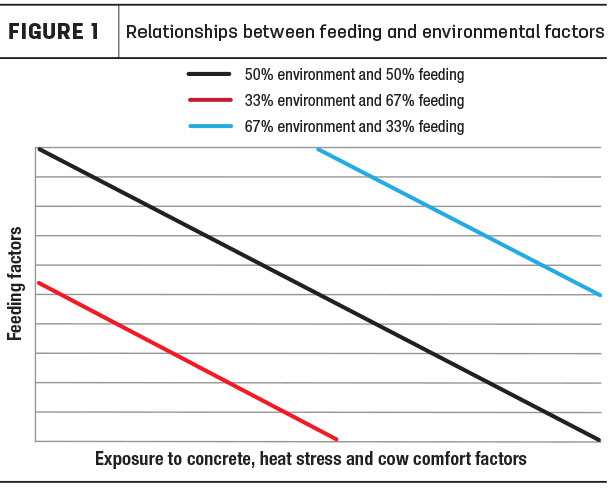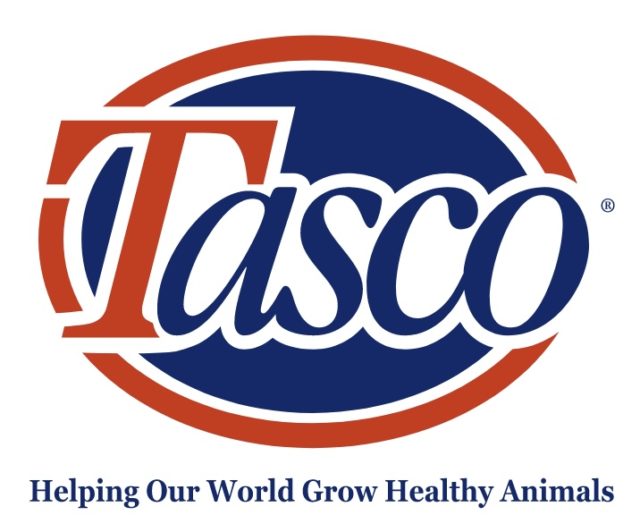(Lameness can be a factor leading to lower fertility also.) Figure 1 illustrates the cows’ environment, along with feeding, can have impact on lameness incidence depending where the diagonal line appears on your dairy farm.

Nutrition will not solve lameness alone; hoof trimming, footbaths, genetics and cow housing should also be considered.
Laminitis is an inflammation in the hoof area causing disrupted blood flow to the corium. Inflammation of the laminae can compromise blood supply and nutrient delivery to the keratin-producing cells that affect horn tissue quality. Potential causes of laminitis can be found in research reports and field observations.
- Excessive rumen-fermentable carbohydrates can lead to higher levels of lactic acid (strong acid dropping rumen pH) and an increase in rumen fluid osmolality.
- Blood histamine is increased after the death of gram-negative bacteria releasing endotoxin-causing blood pooling in the claw. Protein degradation in the rumen also could contribute to histamine production.
- Rumen acidosis produces a toxin which activates a metalloproteinase (MMP) that breaks down bonds between the epidermis of the hoof wall and soft tissue in the corium, leading to sole ulcers and white-line abscesses.
- A lack of fat cushion that is a complex structure composed of adipose tissue located under the distal phalanx. This structure reduces compression of the corium tissue.
- Deficiency of minerals and vitamins can be a factor.
Nutritional factors should be considered when focusing on lameness on farms. These factors along with recommended guidelines for each nutrient or feeding concern are listed below:
Subacute rumen acidosis (SARA) can be a factor in hoof disorders, as it can lead to laminitis. Factors that can lower rumen pH below 6 include high levels of rumen-fermentable starch and sugars, poly-unsaturated fatty acids (PUFA), high dry matter intakes (DMIs) shifting rate of feed passage, slug feeding of grain (over 5 pounds of DM per meal), forages lower in natural buffering capacity (such as corn silage), forages processed too short reducing cud chewing (less than 10 millimeters), wet rations (over 55 percent moisture), high-quality pasture (lack of functional fiber), empty feedbunks (over two hours resulting in engorgement of feed) and feed sorting (allows dairy cows to consume high levels of fermentable carbohydrates).
A suboptimal transition program can lead to rumen acidosis and risks, as dry cows consuming high-fiber rations are moved to rations containing higher levels of grain and less forage. This can lead to hoof disorders observed 100 days after calving. Physically effective fiber maintains a rumen forage raft to optimize rate of passage and normal rumination (over 500 to 600 minutes of cud chewing activity per day). Rumen pH should be maintained above 6.0 related to saliva production rich in sodium bicarbonate. Five pounds of forage particles over 0.75 inch, 21 percent forage neutral detergent fiber (NDF) or 19 to 21 percent effective NDF are suggested minimum levels.
Recommendation: Rumination collars to measure on-farm cud chewing time and the Penn State particle box to evaluate feed particle size can both be effective tools to use on dairy farms to evaluate effective fiber.
Starch and sugar leads to greater DMI and increase in volatile fatty acid (VFA) production. These carbohydrates can shift fermentation from fiber digestion and increase levels of propionic and lactic acids. Grain particle size (finely ground less than 500 microns), grain processing (steam flaking or high-moisture grain over 28 percent moisture) and starch source (wheat versus corn grain) impact the rate of rumen fermentation. Sugars have faster rates of rumen fermentation (found in high-quality pasture, for example).
Recommendation: Suggested starch levels in the total ration DM is 24 to 28 percent starch and 5 to 7 percent sugar in the total ration DM.
Protein quality and quantity can affect hoof hardness. High levels of degradable protein and total protein may lead to rumen fermentation products that can affect foot health.
Recommendation: Balance rations based on metabolizable protein (MP) requirements using a rumen-modeling program to avoid excessive nitrogen while meeting amino acid needs for milk yield.
Unsaturated fats and oils can reduce fiber digestion, shift VFA patterns or lower rumen pH, depressing fiber-digesting bacteria. Limit added vegetable oil to 2.5 percent as oilseeds, free oil (not contained in the oil seed cell) to 225 grams per cow per day or fish oil to 50 grams per day. Feeding rumen-inert fatty acid sources reduces rumen fermentation changes. Total levels of PUFA should be under 500 grams per cow per day.
Recommendation: Keep total ration ether extract below 6 percent of the ration DM and balance sources of added fats and oils.
Copper is needed for synthesis and maintenance of elastic tissue such as tendons. Copper can affect the claw by increasing the production of a copper enzyme, thiol oxidase, increasing hoof hardness through disulfate bonds in keratin. Immunity and antioxidant activity by superoxide dismutase need copper for cell membrane protection. Cattle deficient in copper are more susceptible to heel, foot rot and sole abscesses.
Recommendation: Suggested level of total copper in the ration DM is 10 to 15 parts per million (ppm) (one-third from organic copper sources).
Manganese is needed for normal bone density and joint structure. It is required for chondroitin sulfate synthesis in its role in joint cartilage. Manganese has a role as a superoxide scavenger, decreasing free radicals that can lead to oxidative damage.
Recommendation: Suggested level of manganese is 40 to 60 ppm with one-third from organic sources.
Sulfur is needed for sulfur-containing amino acids synthesized by rumen bacteria, vitamins (biotin and thiamine) and chondroitin sulfate. Harder hooves have been reported with added sulfur by strengthening associated protein bonds.
Recommendation: Suggested levels of total sulfur is 0.25 to 0.28 percent in the total ration DM.
Zinc improves claw integrity through wound healing, epithelium maintenance, and keratin synthesis and maturation. Synthesis of collagen, keratin and related protein-keratin compound require zinc for enzyme function.
Recommendation: Zinc levels in the total ration DM is 40 to 60 ppm (one-third organic zinc sources).
Vitamin A is important for epithelial skin and bone health. A deficiency can result in inflammation of the coronary band of the hoof.
Recommendation: Suggested supplemental levels of vitamin A range from 75,000 to 100,000 international unit (IU) per cow per day.
Biotin is needed for keratin formation and claw horn development, leading to foot disorders during deficiencies in cattle and horses. Biotin can increase milk yield by 4 pounds. Milk production increases were not related to hoof improvement due to the immediate milk response.
Recommendation: Adding 20 milligrams per cow/day is suggested.
Buffers include sodium bicarbonate, sodium sesquicarbonate or potassium carbonate are rumen buffers that maintain an optimal rumen pH.
Recommendation: Suggested levels of sodium bicarbonate or sodium sesquicarbonate are 0.75 percent of total ration DM. Potassium and sodium buffers are added to raise the dietary cation-anion balance to a positive 400-plus milliequivalent (meq) per kilogram during heat stress.
Direct-fed microbial (DFM) or probiotics include yeast products and live bacteria that can reduce lactic acid levels in the rumen, increase fiber digestion or stabilize the rumen environment.
Recommendation: Check DFM products for controlled research results, as numerous commercial products are available with different bacterial combinations.
Monensin reduces lactic acid levels in the rumen while lowering ketosis risk in transition cows that can maintain feed intake and meet nutrient needs. Monensin can also lead to smaller and more meals per day that reduce shifts in the rumen environment based on feedlot data.
Recommendation: Add 300 to 400 milligrams per cow per day.
Body condition scores (BCS) are positive associated with digital cushion thickness (DCT), which can provide cushion to the hoof support structure. Cows with the highest DCT score/thickness had 15 percent lower lameness score compared to the lowest-DCT-scored cows. The DCT continued to drop after parturition, reaching the lowest level at 120 days after calving.
Recommendation: Monitor changes in BCS after calving, minimizing BCS losses to less than 0.5 point (on a 1-to-5 scale).
Heat stress can lead to a drop in rumen pH values by 0.2 point (for example from pH 6.0 to 5.8 units) as cows experience respiratory acidosis and a drop in blood carbon dioxide and bicarbonate. Cow responses to heat stress include lower and variable DMI due to heat stress, a decrease in rumination as cows may be panting, more sorting of feed and shift of blood flow to the surface area of the cow for heat transfer.
Recommendations: Dairy managers may shift ration ingredients, increasing concentrate feeding, lower forage and fiber levels, and added fats/oils that can affect rumen fermentation. Increasing the dietary cation - anion difference (DCAD) to over 400-plus meq per kilogram of ration DM can be effective. ![]()

-
Mike Hutjens
- Professor of Animal Sciences
- Emeritus - University of Illinois – Urbana






